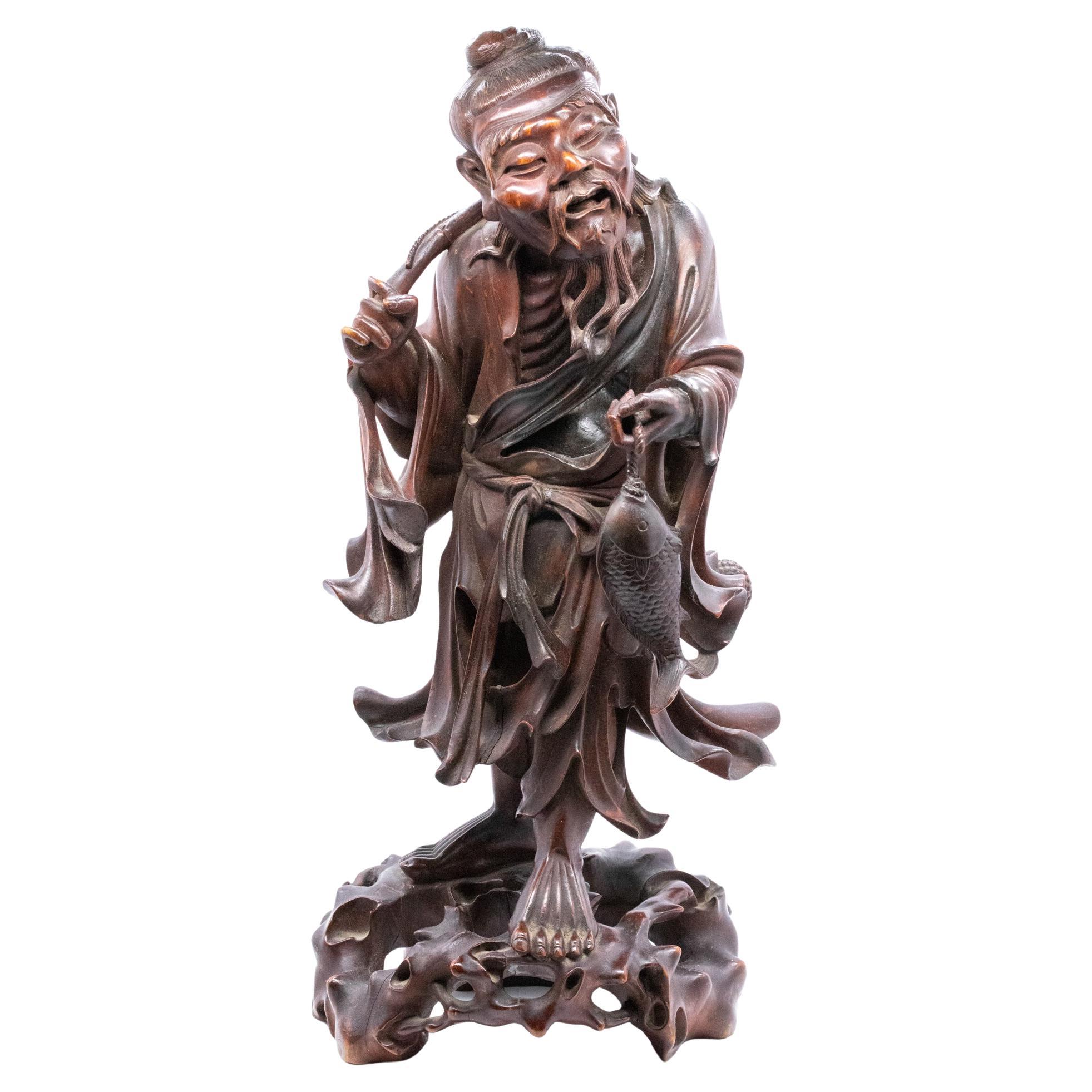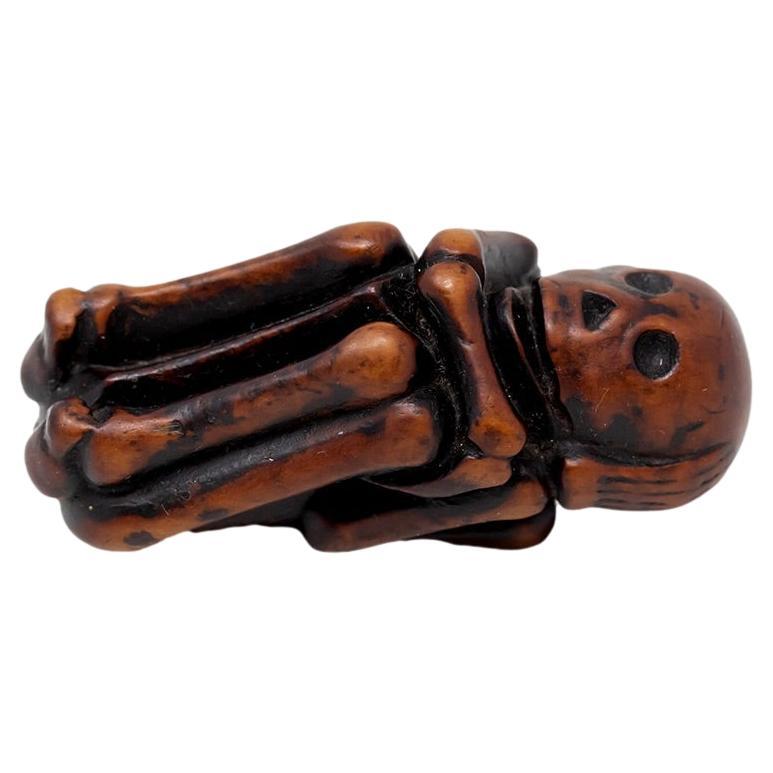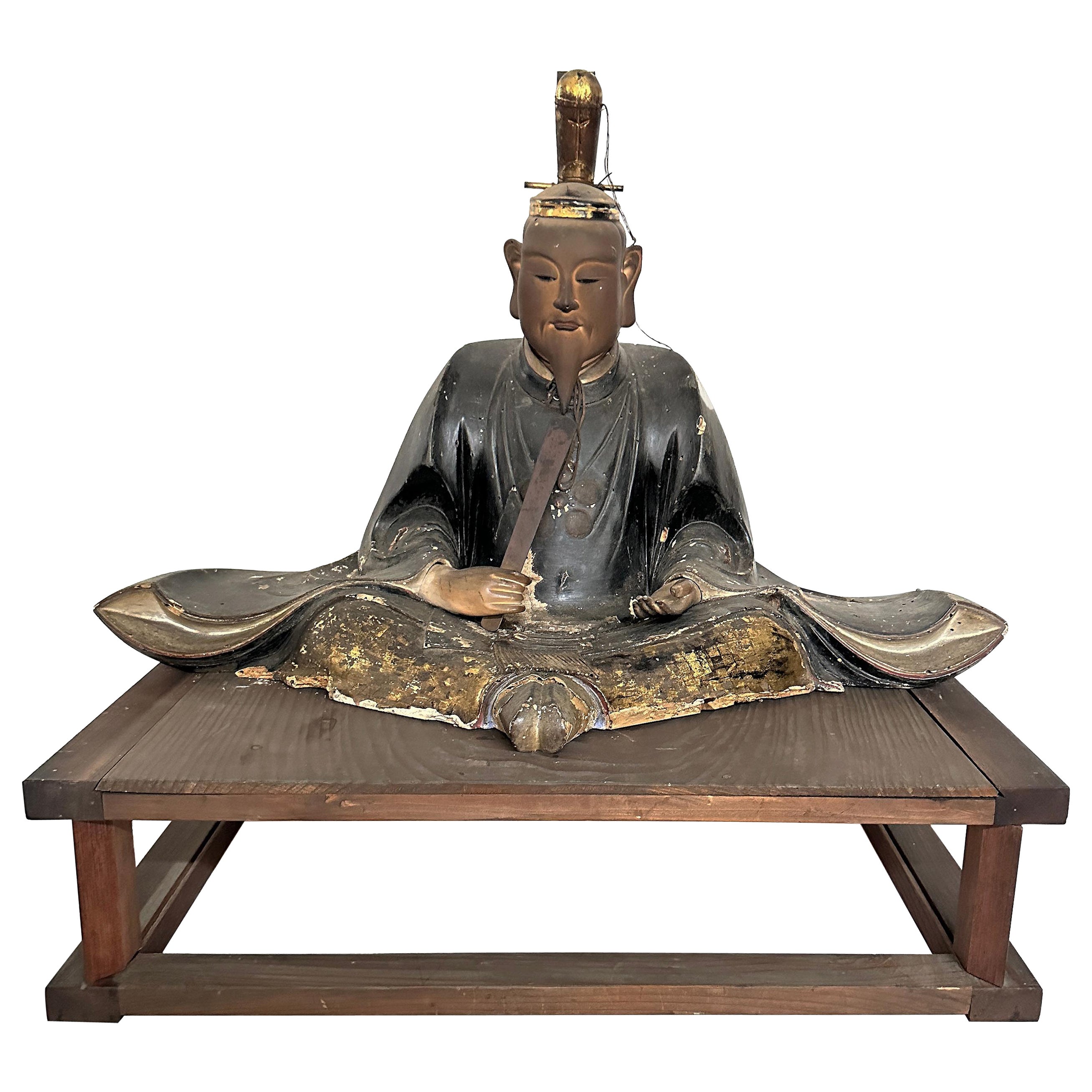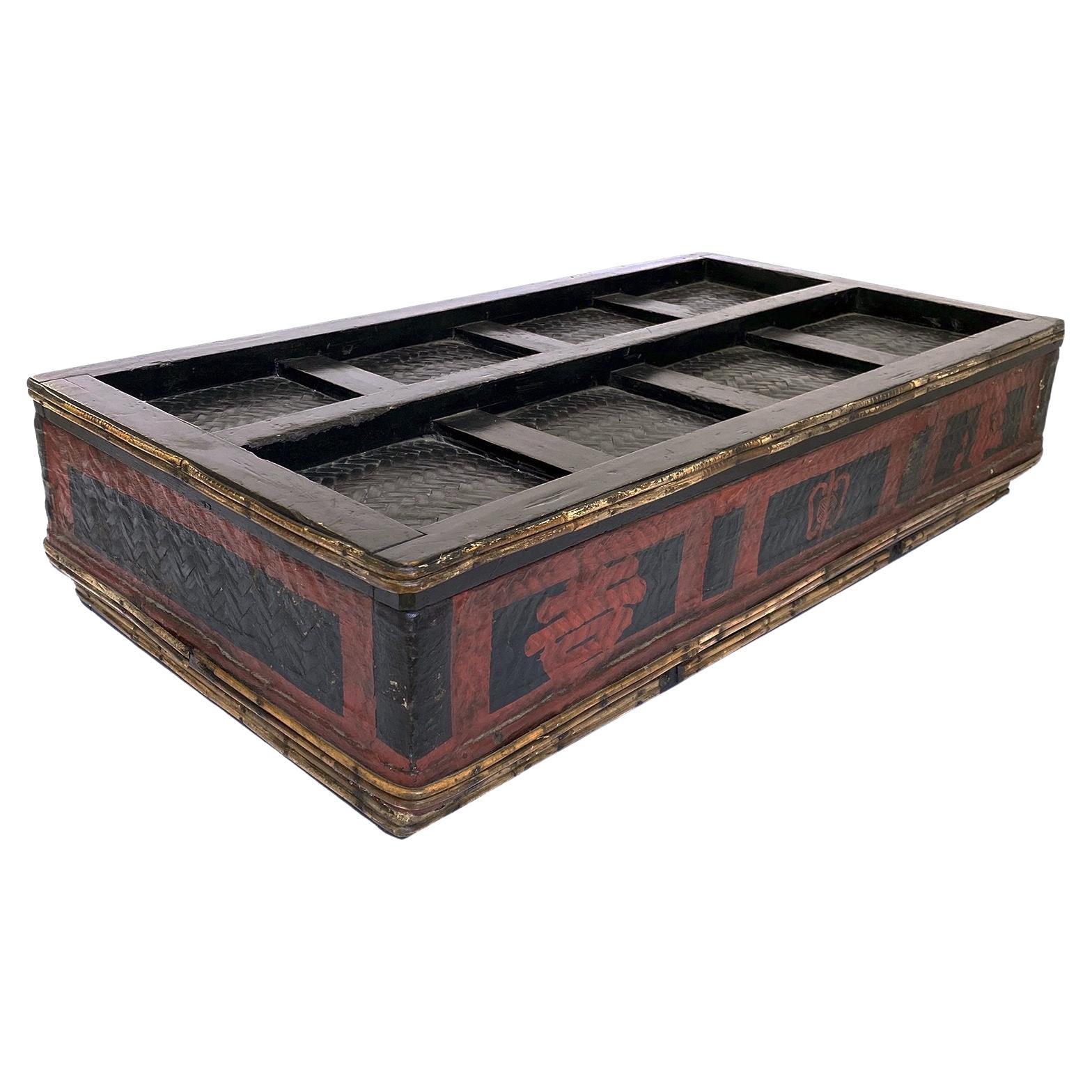Items Similar to Japan 1890 Meiji Period Signed Assembling of Okimono with a Group of Skeletons
Want more images or videos?
Request additional images or videos from the seller
1 of 12
Japan 1890 Meiji Period Signed Assembling of Okimono with a Group of Skeletons
About the Item
A signed Okimono from the Japanese Meiji period (1868-1912).
Very rare, unusual and large sculptural assembling of a dysplaying piece of okimono. Created in Japan during the imperial period of the Meiji (1868-1912). This extraordinary piece okimono sculpture depict a group of four intricately and realistically rendered carousing males skeletons representations (Gaikotsu) standing in several position.
One skeleton is crouched down playing with mouses in the floor. The second is seated resting in the other's back, peacefully smoking opium. The others two are fully standing in interacting position. The entire composition is arranged freely displayed on the wood base including a woven basket, apparently with food and four playfull mouses.
There are an extra five mouses in different positions, freely playing around, all of them with the eyes accented with carved black ebony.
The composition is displayed on a four-legged free form carved wood platform with an inlaid red plaque engraved with the artist's signature. The level of detail and the quality of the carving is truly exceptional.
Has an exact measurements of 216.15 mm by 139.7 mm by 359.41 mm (8.51 x 5.5 x 14.15 Inches).
After an extensive collection of data, comparables and references to this piece, we have only been able to find only three okimono sculptures like this, with similar themes and the same quality of work.
References Note: A similar carving of four skeletons playing an animated game of dominos, signed Shutaro in an inlaid rectangular red plaque, was sold in London by Christie’s South Kensington in October 14 2014, Lot 120 Sale 5546.
References Note: A similar carving with four skeletons in an otherwise typical victorian scene of a photographer and three sitters signed Shutaro in an inlaid rectangular red plaque, was sold in Edinburgh at Lyon & Turnbull in November 7, 2018.
References Note: A similar carving with five skeletons seated, playing cards and drinking, was sold in London by John Nicholson Fine Art on September 26, 2018.
Meiji period, is an era of Japanese history that extended from October 23, 1868 to July 30, 1912.The Meiji era was the first half of the Empire of Japan, when the Japanese people moved from being an isolated feudal society at risk of colonization by Western powers to the new paradigm of a modern, industrialized nation state and emergent great power, influenced by Western scientific, technological, philosophical, political, legal, and aesthetic ideas. As a result of such wholesale adoption of radically different ideas, the changes to Japan were profound, and affected its social structure, internal politics, economy, military, and foreign relations. The period corresponded to the reign of Emperor Meiji. It was preceded by the Keio era and was succeeded by the Taisho era, upon the accession of Emperor Taisho.
Okimono, is a Japanese term meaning for display an ornament; art object; or decorative object, usually displayed in a tokonoma or butsudan "Buddhist altar". It is an ornament or figure, especially one placed in a guest room. An okimono may be a small Japanese carving, similar to but larger than a netsuke. Unlike the netsuke, which had a specific purpose, the okimono is exclusively decorative and was displayed in the tokonoma. During the Meiji period, many okimonos were made for export to the West.
Gaikotsu, meaning skeleton often appears in ancient Japanese myths and Youkai drawings. Skeleton with only human bones are called "sharekoube". Some of other famous skeleton based Youkai are Gasha Dokuro, Honeonna and Kyoukotsu.
Important Note: Regarding antique tortoise shell or ivory, we are great supporters of protection for endangered species in our modern world. We never buy or sell anything 100 years or newer, we don't hunt, knowing those measures also protect the animals in the wild today. We also recognize the vast cultural history we preserve with our care and reverence for these antique objects, and agree with cites that objects over 100 years of age have nothing whatsoever to do with species depletion in our current world.
Condition: The overall condition of this piece is exceptional with no missing or broken parts, not even show any restoration. This piece has been carefully inspected to guarantee the condition and authenticity.
INVENTORY REF: D0000SAEM/.1111
- Dimensions:Height: 8.51 in (21.62 cm)Width: 14.15 in (35.95 cm)Depth: 5.5 in (13.97 cm)
- Style:Meiji (Of the Period)
- Materials and Techniques:
- Place of Origin:
- Period:
- Date of Manufacture:1890
- Condition:Wear consistent with age and use. The overall condition of this piece is exceptional with no missing or broken parts, not even show any restoration. This piece has been carefully inspected to guarantee the condition and authenticity.
- Seller Location:Miami, FL
- Reference Number:
About the Seller
5.0
Platinum Seller
These expertly vetted sellers are 1stDibs' most experienced sellers and are rated highest by our customers.
1stDibs seller since 2023
63 sales on 1stDibs
Typical response time: <1 hour
- ShippingRetrieving quote...Ships From: Miami, FL
- Return PolicyA return for this item may be initiated within 1 day of delivery.
More From This SellerView All
- Japan 1890 Meiji Period Signed Okimono Sculpture of a Group of Skeletons SmokingLocated in Miami, FLSculptural signed Okimono from the Japanese Meiji period (1868-1912). Very rare, unusual and large sculptural assembling of a dysplaying piece of okimono. Created in Japan during the imperial period of the Meiji (1868-1912). This extraordinary okimono was carefully carved depicting a group of three intricately and realistically rendered carousing skeletons (Gaikotsu) in relax and resting position, drinking and smoking. Two of them, probably males representations are resting on a wicker sofa. The third, is a woman seated in a lower stool offering drinking cups of sake on a round tray. A small rectangular bench is arranged in the scene. The composition is displayed on a four-legged carved wood platform with an inlaid red plaque engraved with the artist's signature. The level of detail and the quality of the carving is truly exceptional. Has an exact measurements of 209.55 mm by 196.85 mm by 127.76 mm (8.25 x 7.75 x 5.03 Inches). After an extensive collection of data, comparables and references to this piece, we have only been able to find only three okimono sculptures like this with similar themes and the same quality of work. References Note: A similar carving of four skeletons playing an animated game of dominos, signed Shutaro in an inlaid rectangular red plaque, was sold in London by Christie’s South Kensington in October 14 2014, Lot 120 Sale 5546. References Note: A similar carving with four skeletons in an otherwise typical victorian scene of a photographer and three sitters signed Shutaro in an inlaid rectangular red plaque, was sold in Edinburgh at Lyon & Turnbull in November 7, 2018. References Note: A similar carving with five skeletons seated, playing cards and drinking, was sold in London by John Nicholson Fine Art on September 26, 2018. Meiji period, is an era of Japanese history that extended from October 23, 1868 to July 30, 1912. The Meiji era was the first half of the Empire of Japan, when the Japanese people moved from being an isolated feudal society at risk of colonization by Western powers to the new paradigm of a modern, industrialized nation state and emergent great power, influenced by Western scientific, technological, philosophical, political, legal, and aesthetic ideas. As a result of such wholesale adoption of radically different ideas, the changes to Japan were profound, and affected its social structure, internal politics, economy, military, and foreign relations. The period corresponded to the reign of Emperor Meiji. It was preceded by the Keio era and was succeeded by the Taisho era, upon the accession of Emperor Taisho. Okimono, is a Japanese term meaning for display an ornament; art object; or decorative object, usually displayed in a tokonoma or butsudan "Buddhist altar". It is an ornament or figure, especially one placed in a guest room. An okimono may be a small Japanese...Category
Antique 1890s Japanese Meiji Sculptures and Carvings
MaterialsWood
- Japan 1890 Meiji Period Ebisu Sculpture in Wood Carving of an Old FishermanLocated in Miami, FLAn extremely well detailed wood carving of Ebisu, as a fisherman. Beautiful and well detailed sculpture, created in Japan during the Meiji dynastic period (1868-1912) back in the 1890's. This piece represent the god of good fortune Ebisu. Was exceptionally carved and executed from one solid single piece of rose wood, showing a gorgeous face expression, with intricate details in the hands and feets, he's carrying as usual a rod and a fish. Ebisu (yebisu), ???, god of fortune, the ocean and fisherman. In the japanese mythology is one of the seven gods of luck, sichi-fuku-jin, the patron of the fisherman and tradesmen. he is depicted as a bearded, smiling fisherman with formal long court ropes, often carrying a rod in one hand and a tai, symbolic fish of the good luck, in the other. The height is 14.25 inches (36.20 cm) and the base measurements is 6.5 by 6.45 inches (16.5 x 16.38 cm). Meiji period, is an era of Japanese history that extended from October 23, 1868 to July 30, 1912.The Meiji era was the first half of the Empire of Japan, when the Japanese people moved from being an isolated feudal society at risk of colonization by Western powers to the new paradigm of a modern, industrialized nation state and emergent great power, influenced by Western scientific, technological, philosophical, political, legal, and aesthetic ideas. As a result of such wholesale adoption of radically different ideas, the changes to Japan were profound, and affected its social structure, internal politics, economy, military, and foreign...Category
Antique 1890s Japanese Meiji Sculptures and Carvings
MaterialsWood
- Japan 1890 Meiji Period Rare Carved Okimono Of A Father And Son Playing SignedLocated in Miami, FLJapanese Okimono sculpture of a father and son. Very rare and highly detailed sculpture, created during the meiji period (1868-1912) in the imperial Japan, circa 1890. This sculptural Okimono is very well realized and exceptionally proportionate. Show the figures of a father and a son playing, with happiness and smiling. The father hold a big basket at his back and both personages are wearing kimonos richly engraved. This piece was made from a carving with exceptional craftsmanship and intricate details. This sculpture stand itself on his own base and have all retain of the applied ochre ink accents. Measures: 130 mm by 45 mm by 53.3 mm (5.1 x 1.75 x 2.1 inches). Weight: 81.30 grams. Note: This kind of family scene is very rare to seen in nineteenth century japanese iconography. Okimono Is a Japanese term meaning for display an ornament; art object; or decorative object, usually displayed in a tokonoma or butsudan "Buddhist altar". It is an ornament or figure, especially one placed in a guest room. An okimono may be a small Japanese carving, similar to but larger than a netsuke. Unlike the netsuke, which had a specific purpose, the okimono is exclusively decorative and was displayed in the tokonoma. During the Meiji period, many okimonos were made for export to the West. Meiji Period This is an era of Japanese history that extended from October 23, 1868 to July 30, 1912.The Meiji era was the first half of the Empire of Japan, when the Japanese people moved from being an isolated feudal society at risk of colonization by Western powers to the new paradigm of a modern, industrialized nation state and emergent great power, influenced by Western scientific, technological, philosophical, political, legal, and aesthetic ideas. As a result of such wholesale adoption of radically different ideas, the changes to Japan were profound, and affected its social structure, internal politics, economy, military, and foreign relations...Category
Antique 1890s Japanese Meiji Sculptures and Carvings
MaterialsWood, Paint
- Japan 1890 Meiji Carved Figure of Fortune God Daikoku As a Farmer With CoinsLocated in Miami, FLA Japanese carved sculpture of Daikoku. Magnificent sculpture of the god of the fortune Daikoku, created in Japan during the Meiji period, circa 1890. The carving depicts the Japane...Category
Antique 1890s Japanese Meiji Sculptures and Carvings
MaterialsIvory
- Japan 1890 Meiji Shibayama Round Urn in Gilded Wood and Sterling SilverLocated in Miami, FLShibayama urm from the Japan meiji (1858-1912) period. Gorgeous piece of art, created in the imperial Japan during the Meiji period, circa 1890. This is a little urn with a lid crafted in gilded wood, shibayama panels and sterling silver. Composed by a four footed round vase with two sterling silver handles in the shape of trees and the lid on top accented with the figure of a crab in sterling silver. The gilded wood is decorated with flowers, sea patterns and the imperial flower...Category
Antique 1890s Japanese Meiji Antiquities
MaterialsMulti-gemstone, Gold, Silver, Sterling Silver, Gold Leaf
- Japan Meiji 1900 Three Bronze Ducks Sculpture in Wood Stand and CoralLocated in Miami, FLSculptural composition of the ducks from the Japanese Meiji Period. Beautiful and very well realized sculptural composition of three ducks, made during the japanese imperial perio...Category
Antique Early 1900s Japanese Meiji Sculptures and Carvings
MaterialsCoral, Bronze
You May Also Like
- Japanese Skeleton Boxwood Netsuke Late Edo PeriodLocated in Newark, EnglandJapanese boxwood netsuke depicting a skeleton. The skeleton naturalistically carved in the foetal position in preparation for transitional burial. With...Category
Antique Mid-19th Century Japanese Edo Sculptures and Carvings
MaterialsWood, Boxwood
- Tenjin-Sama, Wood, Japanese Shinto Deity of Learning and Wisdom, Meiji PeriodLocated in Point Richmond, CATenjin-Sama, Shinto Deity of Learning and Wisdom, Meiji Period Tenjin,-Sama, Deification of Sugawara no Michizane, was a famous scholar, poet and politician of the Heian period. In...Category
Antique Late 19th Century Japanese Meiji Sculptures and Carvings
MaterialsWood
- Meiji Period Red and Black Painted Kimono Storage Box, JapanLocated in Point Richmond, CAJapanese Kimono storage box, constructed of wood and bamboo, painted black with family crest painted in red on the sides. The top has wood slats, which ...Category
20th Century Japanese Meiji Sculptures and Carvings
MaterialsWood
- Antique Japanese Meiji Period Kneeling Samurai Warrior, Circa 1870-1880Located in Savannah, GAAntique Japanese Kneeling Samurai Warrior, Circa 1870-1880. Japanese Meiji period samurai with detailed presentation of robes and helmet.Category
Antique 19th Century Japanese Meiji Sculptures and Carvings
MaterialsFabric
- Japanese Meiji Noh Mask of OkinaLocated in New York, NYJapanese carved wood Noh mask depicting Okina. The piece was made during the late Edo - early Meiji period in the 19th century. The mask is of an older man wi...Category
Antique 19th Century Japanese Meiji Sculptures and Carvings
MaterialsWood
- Japanese Meiji Period Carved Wood Okimono Man with RabbitsLocated in Newark, EnglandThe charming figure, carved from a single piece of wood is exceptionally carved showing the male figure with humorous expression holding two Rabbits one by the ears and the second under his arm. A third Rabbit stands at the feet of the male looking up, each rabbit with a different expression. The male figure is wearing traditional Japanese attire with his hair tied back stood upon a naturalistic base. The figure dates to the Meiji Period (1868-1912) circa 1900. Notes The Rabbit is one of the 12 animals to feature in the Japanese Zodiac signs which follows the Chinese astrological system along with the Rat, Ox, Tiger, Rabbit, Dragon, Snake, Horse, Goat, Monkey, Rooster, Dog, Pig. Such division is connected with the Jupiter cycle around the Sun, which lasts about 12 years. As 2023 is the year of the Rabbit...Category
Antique Early 1900s Japanese Meiji Sculptures and Carvings
MaterialsWood
Recently Viewed
View AllMore Ways To Browse
Modern 1890
Signed Carving
Antique Wood Levels
Antique Signs Sale
1890 Japan
Modern Wood Carving
Seat And A Half
Antique Sign Restoration
Rectangular Carving
Large Antique Wood Signs
Group Of 7
Japanese Emperor
Emperor Japan
Sale Japanese
Asian Art Ivory
Carved Ivory Antique
Ivory Carved Antique
Carved Antique Ivory





